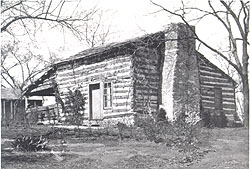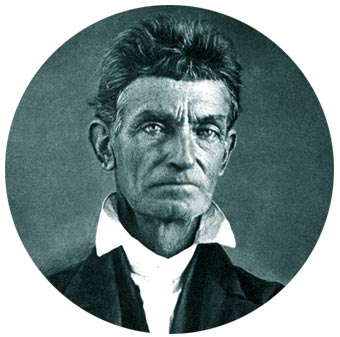John Brown
(Torrington, EE UU, 1800-Charlestown, id., 1859) Activista abolicionista estadounidense. Nacido en el seno de una familia de profundas convicciones religiosas, pasó buena parte de su adolescencia en una comunidad proabolicionista en Ohio. Entre 1825 y 1855 residió en Pensilvania, Massachusetts y Nueva York, ejerciendo diversos oficios. Muy activo políticamente, era un acérrimo defensor de las ideas antiesclavistas. En 1849 se trasladó con su familia a una comunidad de color fundada en North Elba, en el estado de Nueva York, cuyas tierras habían sido donadas por el filántropo antiesclavista Gerrit Smith.
En 1855, cinco de sus hijos le pidieron que fuera a Kansas en su ayuda, donde habían entrado en conflicto con un grupo de terratenientes proesclavistas por el control del territorio. Llevó consigo un cargamento de armas y municiones y se asentó en Osawatomic, erigiéndose rápidamente en líder de las guerrillas proabolicionistas de la región.
Al año siguiente, los grupos proesclavistas atacaron la localidad de Lawrence; Brown lideró una expedición armada a Pottawatomie, campamento proesclavista, y ahorcó a cinco de sus ocupantes. El suceso, que Brown defendió afirmando que no sólo estaba justificado, sino que incluso había sido inspirado por Dios, agravó el conflicto de fondo que daría pie a la guerra civil.
En 1858 organizó un encuentro interracial con el objetivo de fundar, en los estados de Maryland y Virginia, una comunidad que acogiera a los esclavos fugitivos. Convertido en portavoz del movimiento abolicionista, promulgó una Constitución provisional en la que se erradicaba la esclavitud y, en este estado dentro del Estado, le fue otorgado el cargo de comandante en jefe. Sin embargo, su suerte se torció en el verano de 1859, cuando, tras atacar una plaza militar federal, fue detenido, juzgado y ahorcado.
John Brown Museum


During 1854-1855 many Northern newspapers urged people to move to Kansas, a new land of opportunity. The pioneer family could cultivate fertile land, enjoy the peaceful countryside, and protect the territory from the spread of slavery. This was the dream of
Samuel Adair and
Florella Brown Adair, both graduates of Oberlin, a progressive coeducational and biracial college in Ohio. Samuel finished his theology program while he courted Florella. Then they married and moved westward.
Five of the sons of
John Brown, Florella's half brother, soon followed the Adairs to Kansas, bringing with them their families and expectations for a better life in the new territory. After settling in the Osawatomie area, severe illness and the "clouds of war" closed in on the pioneers. John Brown came to Kansas to help his sons, although he did not plan to stay permanently in the new territory. In Kansas the steadfast abolitionist found a place where he could act on his radical ideas. The territory officially was under the control of a proslavery government which sometimes prompted free-state men to take desperate action. They fought armed proslavery men, often from Missouri, who invaded the territory, destroying crops and murdering free-state opponents. These troubled times became known as Bleeding Kansas. Osawatomie was attacked and burned by proslavery forces on August 30, 1856, but the Adair Cabin, located some distance northwest of the town, survived.
Pioneer life was difficult enough under any circumstances. The Adairs were exceptional people who faced incredible hardships. As a Congregational minister, Reverend Samuel Adair struggled to gather a faithful flock. The walnut lumber and native stone used in the construction of the church building were supplied from his own claim. This was the first church in Osawatomie and the third of its denomination in Kansas. The work on the meeting house was a labor of love and a source of comfort in troubling times. It was dedicated July 14, 1861, and still stands.
The Civil War, when it came in 1861, separated the Adairs. Samuel served at Fort Leavenworth as military chaplain, while Florella added her husband's responsibilities to her own at home. Eventually ill health forced her to join Samuel at Leavenworth, where she died in 1865.
Following the death of his wife, Samuel returned to his church and cabin in Osawatomie. He helped establish the first insane asylum in Kansas (present-day Osawatomie State Hospital), giving his services voluntarily as chaplain for eleven years. Samuel died in 1898, leaving the cabin to his son, Charles Storrs Adair.
In 1912 the Adair cabin was dismantled and relocated to the John Brown Memorial Park. In 1928 the state of Kansas appropriated $6,000 of a stone pergola to surround the cabin, protecting it from further deterioration. The state legislature appointed the Kansas Historical Society to maintain the site, and it does so in partnership with the city of Osawatomie. The site was listed in the National Register of Historic Places in 1971 and now operates as
John Brown Museum State Historic Site.
 |
The John Brown Cabin
Photograph taken prior to the 1928 enclosure of the cabin.
Courtesy of the Kansas Historical Society.
|
The John Brown Cabin was built in 1855 by Samuel Glenn, who sold it to Samuel Adair, Brown's brother-in-law. Brown frequented the cabin and occasionally used it as a headquarters for his abolitionist activities. Built about a mile west of Osawatomie, the log cabin was dismantled and reassembled in its present location, John Brown Park, in 1912. A stone pavilion was constructed around the cabin in 1928, however the interior of the cabin remains much as it was when Brown was a frequent visitor and contains much of the original furniture. John Brown only lived in Kansas for about 20 months, but his abolitionist activities leading up to his infamous raid on Harper's Ferry have been closely associated with the state.
El edificio de piedra contiene la cabina original construido por Samuel Adair donde John Brown se mantuvo durante parte de su tiempo en Kansas.
(...) In the spring of 1855, abolitionists the Reverend Samuel and Florella Adair and their children occupied the cabin inside this building. The same year, Florella's half brother, John Brown, and five of his sons settled near Osawatomie, Kansas. The Browns and Adairs became intensively involved in the conflict known as Bleeding Kansas.
The Adair home was a stop on the underground Railroad. Among the fugitive slaves that stayed briefly in the cabin, were the slaves which John Brown liberated during a raid on Stokesbury, Missouri in 1858. Although 11 slaves were freed, a baby was born to "Sam" and "Jane" during the flight to Osawatomie and 12 African Americans were brought to the cabin.
Following his work as a Chaplain at Fort Leavenworth, Reverend Adair returned to Osawatomie and lived in the cabin until his death in 1898. The cabin was moved into town and pavilion erected around it in 1928, creating the John Brown Museum. The park where it now located was the site of the Battle of Osawatomie where free-state and pro-slavery men fought on August 30, 1856.
The John Brown Museum is more interesting than it looks from the outside, and the curator provides an excellent tour. Plan to allow 30-40 minutes for your visit. When you leave the John Brown Museum pick up a copy of the
Osawatomie
John Brown Cabin, North Elba, New York
La cabina de Adair en 1928 antes de que el Museo de John Brown fue construido a su alrededor.


 During 1854-1855 many Northern newspapers urged people to move to Kansas, a new land of opportunity. The pioneer family could cultivate fertile land, enjoy the peaceful countryside, and protect the territory from the spread of slavery. This was the dream of Samuel Adair and Florella Brown Adair, both graduates of Oberlin, a progressive coeducational and biracial college in Ohio. Samuel finished his theology program while he courted Florella. Then they married and moved westward.
During 1854-1855 many Northern newspapers urged people to move to Kansas, a new land of opportunity. The pioneer family could cultivate fertile land, enjoy the peaceful countryside, and protect the territory from the spread of slavery. This was the dream of Samuel Adair and Florella Brown Adair, both graduates of Oberlin, a progressive coeducational and biracial college in Ohio. Samuel finished his theology program while he courted Florella. Then they married and moved westward.


No hay comentarios:
Publicar un comentario